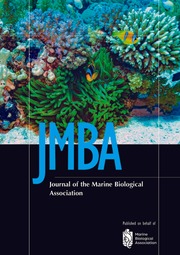Crossref Citations
This article has been cited by the following publications. This list is generated based on data provided by
Crossref.
Aizenberg, Joanna
Sundar, Vikram C.
Yablon, Andrew D.
Weaver, James C.
and
Chen, Gang
2004.
Biological glass fibers: Correlation between optical and structural properties.
Proceedings of the National Academy of Sciences,
Vol. 101,
Issue. 10,
p.
3358.
Villalobos, José Luis
Alvarez, Fernando
and
Iliffe, Thomas M.
2006.
Macromaxillocarididae, a New Family of Stenopodidean Shrimp from an Anchialine Cave in the Bahamas, with the Description of Macromaxillocaris Bahamaensis, N. Gen., N. Sp..
Journal of Crustacean Biology,
Vol. 26,
Issue. 3,
p.
366.
De Almeida Fernandes, Lohengrin Dias
Peixoto, Bruno José F.S.
De Almeida, Eduardo V.
and
Bonecker, Sérgio Luiz Costa
2010.
Larvae of the family Stenopodidae (Crustacea: Stenopodidea) from South Atlantic Ocean.
Journal of the Marine Biological Association of the United Kingdom,
Vol. 90,
Issue. 4,
p.
735.
Chak, Solomon T. C.
Bauer, Raymond
and
Thiel, Martin
2015.
Social Recognition in Invertebrates.
p.
57.
Chen, Chien-Lin
Goy, Joseph W.
Bracken-Grissom, Heather D.
Felder, Darryl L.
Tsang, Ling Ming
and
Chan, Tin-Yam
2016.
Phylogeny of Stenopodidea (Crustacea : Decapoda) shrimps inferred from nuclear and mitochondrial genes reveals non-monophyly of the families Spongicolidae and Stenopididae and most of their composite genera.
Invertebrate Systematics,
Vol. 30,
Issue. 5,
p.
479.
Xu, Peng
Zhou, Yadong
and
Wang, Chunsheng
2017.
A new species of deep-sea sponge-associated shrimp from the North-West Pacific (Decapoda, Stenopodidea, Spongicolidae).
ZooKeys,
Vol. 685,
Issue. ,
p.
1.
Sun, Shao'e
Sha, Zhongli
and
Wang, Yanrong
2018.
Complete mitochondrial genome of the first deep-sea spongicolid shrimp Spongiocaris panglao (Decapoda: Stenopodidea): Novel gene arrangement and the phylogenetic position and origin of Stenopodidea.
Gene,
Vol. 676,
Issue. ,
p.
123.
Wortham, Jen L
and
VanMaurik, Lauren
2019.
Gill fouling in the economically important freshwater shrimp Macrobrachium rosenbergii (De Man, 1879) (Caridea: Palaemonidae).
Journal of Crustacean Biology,
Bochini, Gabriel L
Cunha, Andressa M
Terossi, Mariana
and
Almeida, Alexandre O
2020.
A new genus and species from Brazil of the resurrected family Macromaxillocarididae Alvarez, Iliffe & Villalobos, 2006 and a worldwide list of Stenopodidea (Decapoda).
Journal of Crustacean Biology,
Vol. 40,
Issue. 6,
p.
704.
ZHAO, YU
XU, TING
YANG, WEIDI
and
QIU, JIAN-WEN
2021.
A new species of the deep-sea shrimp genus Spongicoloides (Decapoda: Spongicolidae) from the South China Sea.
Zootaxa,
Vol. 5005,
Issue. 3,
p.
276.
Schnabel, Kareen E.
Kou, Qi
and
Xu, Peng
2021.
Integrative Taxonomy of New Zealand Stenopodidea (Crustacea: Decapoda) with New Species and Records for the Region.
Diversity,
Vol. 13,
Issue. 8,
p.
343.
Davis, Katie E
De Grave, Sammy
Delmer, Cyrille
Payne, Alexander R D
Mitchell, Steve
and
Wills, Matthew A
2022.
Ecological Transitions and the Shape of the Decapod Tree of Life.
Integrative and Comparative Biology,
Vol. 62,
Issue. 2,
p.
332.
Morankar, Swapnil
Singaravelu, Arun Sundar Sundaram
Niverty, Sridhar
Mistry, Yash
Penick, Clint A.
Bhate, Dhruv
and
Chawla, Nikhilesh
2022.
Tensile and fracture behavior of silica fibers from the Venus flower basket (Euplectella aspergillum).
International Journal of Solids and Structures,
Vol. 253,
Issue. ,
p.
111622.
Bauer, Raymond T.
2023.
Shrimps.
Vol. 42,
Issue. ,
p.
657.
Bauer, Raymond T.
2023.
Shrimps.
Vol. 42,
Issue. ,
p.
515.
Bauer, Raymond T.
2023.
Shrimps.
Vol. 42,
Issue. ,
p.
19.
ANKER, ARTHUR
2023.
Description of a new genus and new species of deep-water stenopodid shrimp from the western Atlantic, with remarks on Odontozona Holthuis, 1946 and Richardina A. Milne-Edwards, 1881 (Decapoda: Stenopodidea).
Zootaxa,
Vol. 5263,
Issue. 1,
p.
093.
Bauer, Raymond T.
2023.
Shrimps.
Vol. 42,
Issue. ,
p.
69.
McCoy, Dakota E.
Burns, Dale H.
Klopfer, Elissa
Herndon, Liam K.
Ogunlade, Babatunde
Dionne, Jennifer A.
and
Johnsen, Sönke
2024.
Heart cockle shells transmit sunlight to photosymbiotic algae using bundled fiber optic cables and condensing lenses.
Nature Communications,
Vol. 15,
Issue. 1,


